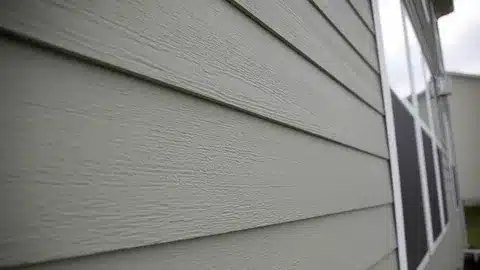Cement siding is one of the best exterior cladding materials used in all types of developmental projects. If you want to invest in the right thing, then explore its benefits, cost, and installation guide through this guide. If we talk about its look, then cement siding provides a beautiful, classic look of wood siding with the best features. It is made up of cement, sand, water, and wood pulp. However, this is one of the best materials that has gained popularity in construction due to its features. If you want a material for fire resistance that requires low maintenance, then cement siding is for you.
If you are worried about managing your budget, then get expert Cement Cost Estimation from a reliable source. It will help you prevent cost overruns and costly surprises in the future.
TRANSFORM YOUR HOME WITH THE BEAUTY OF CEMENT SIDING AND EXPLORE ITS BENEFITS, COSTS, AND INSTALLATION PROCESS FROM OUR GUIDE TO MAKE THE RIGHT DECISION!
What Is Cement Siding?
It is also called fiber cement siding, which is made carefully through the following items:
- Portland cement – Provides strength and structural integrity
- Sand – Adds stability and texture
- Cellulose fibers (wood pulp) – Offers flexibility and reduces cracking
- Water – Binds the components together
- Silica – Enhances durability (in some formulations)
How is it made?
The manufacturing process involves:
- Mixing – Raw materials are blended in precise proportions
- Forming – The mixture is shaped into sheets or planks
- Steam curing – High-pressure steam treatment strengthens the material
- Cutting – Panels are cut to standardized sizes
- Finishing – Products may be pre-primed or pre-painted
Benefits of Cement Siding
Exceptional Durability
Do you know that the life of fiber cement is up to 50 years? Isn’t that amazing? With proper maintenance, you will not require anything to change about it. Plus, it can bear extreme weather conditions.
Fire Resistance
The next thing is that it does not attract insects or termites because it is composed of non-combustible materials. What does that mean? This means that it has a zero flame spread rating.
Weather Resistance
Various building owners have used this material for its excellent resistance to sea salt air. However, it can withstand extreme conditions, including heavy rain and high wind.
Low Maintenance Requirements
The best thing about Fiber cement is that you do not need to invest money in painting or staining more frequently. However, routine cleaning is recommended to prolong its life!
Aesthetic Versatility
Fiber cement siding is available in various types of textures. You can go with wood grain, smooth finishes, or stucco. How? Because fiber cement siding can copy all styles.
Current Costs
Material Costs
You may have to pay between $5 to $10 per square foot for fiber cement siding materials. Let us show you the current cost according to the types:
- Planks cost between $0.70 to $5.00 per square foot
- Shingles cost between $2.50 to $6.50 per square foot
- Panels cost between $1.50 to $4.00+ per square foot
Installation Costs
Labour expenses also cover a large area, which can range between $2 to $8 per square foot according to the projects. So, the total projected cost can be high or low depending on the siding type you choose. Moreover, in which region is the installation required? For more accurate quotes, you should seek estimation services from expert companies.
Step-by-Step Installation Process
1. Preparation
A successful fiber cement siding installation depends on your preparation. Always inspect the exterior of your home before the installation process. Look for any issues like moisture or mold.
Start by attaching a layer of sheathing, like plywood. The next thing is to cover the sheathing with a weather-resistant barrier. Do not forget to cover the entire wall to create complete moisture protection.
2. Layout and Marking
Mark the stud locations with a pencil on the soffit and foundation where they won’t be covered by the building paper. Install the building paper, then follow your stud location marks and snap chalk lines to guide both your nailing and your placement of siding joints.
3. Install Trim and Corners
The first step is to install both the inside and outside corners on the wall. To allow for caulking, ensure at least a ¼” thickness more than two stacked pieces.
4. Install Starter Strip
You will begin with a starter strip with weep holes that will allow moisture to readily escape. You will need a clearance from the grade that either follows installation instructions or local building codes (whichever is greater).
5. Cut and Install Siding
You must be aware of the required height and width of the siding where you are going to install it. After that, you need to cut the panels carefully.
6. Install Siding Planks
Like most siding, you will install the fiber cement boards from the bottom up when using a traditional, horizontal lap application.
Position your first course of siding ¼-inch below the starter strip and nail the siding into the studs 1 inch down from the top of the siding. After that, use galvanized siding nails and make sure that the nails penetrate a minimum of 1-1/4 inches into the framing. Keep in mind that fiber cement siding plants should overlap by 1 to 2 inches.
7. Maintain Proper Clearances
Always be certain that your fiber cement siding is installed six inches or more above the land grade of your home, giving it a 1-2″ gap between steps, decks, or adjoining roofs. 2 inches between siding and roofing, decks, patios, driveways, steps, and walkways.
8. Install Flashing and Trim
Install the flashing correctly over all windows and doors, leaving a 1⁄4″ opening in between siding and flashing. Kick-out flashing is essential for preventing water from running down a roof and behind the siding on an adjacent wall. Next, you need to make sure to process caulking. It will help in sealing all the gaps and cracks. Now your installation process is over.
Conclusion
In short, Cement siding is one of the best investments for building owners. If you want to invest your money in a low-maintenance and aesthetically pleasing option, then siding is for you! However, the initial expense is higher, but it is a great option for long-term investment. Make sure to seek professional help to get the desired performance, or hire an experienced construction estimating company to manage everything well!

